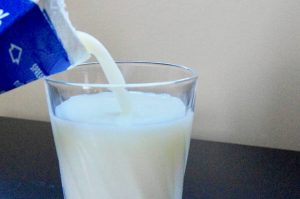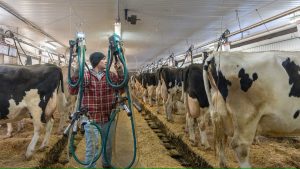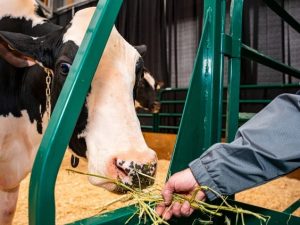
Canadian start-up eyes artificial intelligence-based dairy cow evaluation.
A Canadian start-up company says results from its artificial intelligence-based classification of dairy cows come within two per cent of human results.
Animal science specialist Ghader Manafiazar, one of three co-founders of iClassifier, says through the analysis of approximately 30,000 images collected from Canadian dairy farms, an accuracy rate of 98 per cent was achieved by the company’s machine learning-based approach for classification scores of quantitative Holstein traits such as stature (height at rump) and pin width.
In-person classification services are provided to Canadian dairy farms by Holstein Canada. A Holstein Canada representative said the organization would have more to say later this year about this type of technology.
Correlation to scores given by human classifiers for qualitative traits — such as udder texture and dairy capacity — were around 80 per cent, Manafiazar said, but “we’re trying to come up with a system that can objectively assess at least some of these qualitative traits.”
With close-to-100 per cent accuracy on all traits, the company’s founders are confident there are opportunities to commercialize the system.
Manafiazar, a faculty member at Dalhousie University in Halifax who completed his PhD in dairy cow feed efficiency at the University of Alberta in Edmonton, started the company with Alberta Mechanical Engineering faculty member Reza Sabbagh and data scientist Amir Rahvar.
The company was founded in 2021 and is set to launch a four-farm pilot project in Alberta in early 2024.
The company’s app uses images of cows “and processes them in the cloud using the company’s unique AI algorithm. As many as 25 different traits, including udder texture and depth, bone quality, height and rump angle, can be measured and interpreted for each cow, and after thorough analysis, detailed reports with recommendations are provided to farmers.”
Manafiazar says during his time studying dairy farms in Alberta, he became interested in how information technology could be adopted in the sector.
“I’m blessed with some very smart engineering friends,” he said with a smile during a recent interview.
With his two co-founders, “we had discussions about various topics and ways to bring technology to dairy, but we thought with this one, there is an opportunity.”
Through his prior work at the University of Alberta, Manafiazar got to know Nelson Jespersen, who milks about 300 cows on robots near Westlock, Alta., and regularly welcomes university students to his farm.
Jespersen said he used to classify his herd of Holsteins but stopped having it done because it was inconvenient and not worth the time and expense.
The iClassifier team brought cameras to Jespersen’s farm as part of its research and he says a more streamlined, non-biased approach to classification could entice him to resume the practice.
Sabbagh, the company’s CEO, has a background in optical imaging. He said in an interview that the team analyzed thousands of images collected for classification traits and compared those with results provided by a human classifier.
“The results were fantastic. We thought if we could automate this practice, we could help farmers perform these assessments more frequently, and provide an accurate and objective result they can use to improve the longevity and productivity of their herds,” he says.
Numerous dairy farmers were surveyed about two years ago, Sabbagh says, and “they showed great interest in having iClassifier’s innovative technology on their farms and are even ready to participate in the technology development.”
The company was in Dubai from Oct. 15-18 at Gitex Northstar, a massive tech start-up trade show, for an unveiling of the iClassifier system.
It is also looking to the future, with hopes to expand system capabilities to other livestock, including horses, swine and camels.
A research team led by a University of Alberta mechanical engineering master’s student is working toward the creation of a specialized lameness prediction tool within the iClassifier app. Thanks to support from Mitacs, a not-for-profit organization funded by provincial and territorial governments across Canada, the team is working with the university’s Optical Diagnostics Group to analyze data from the 150-cow Dairy Research and Technology Centre herd on the university’s south campus.
Early lameness detection can allow cows with foot problems to be treated before they become clinical, as often happens now.
Manafiazar says iClassifier has potential to take some qualitative traits and make them quantifiable, and therefore remove human bias. An example is udder texture, which could be quantified by taking separate images of thousands of udders before and after milking and applying machine learning to decide on an ideal.
Body condition score and mastitis detection are other possible applications, he says.

























